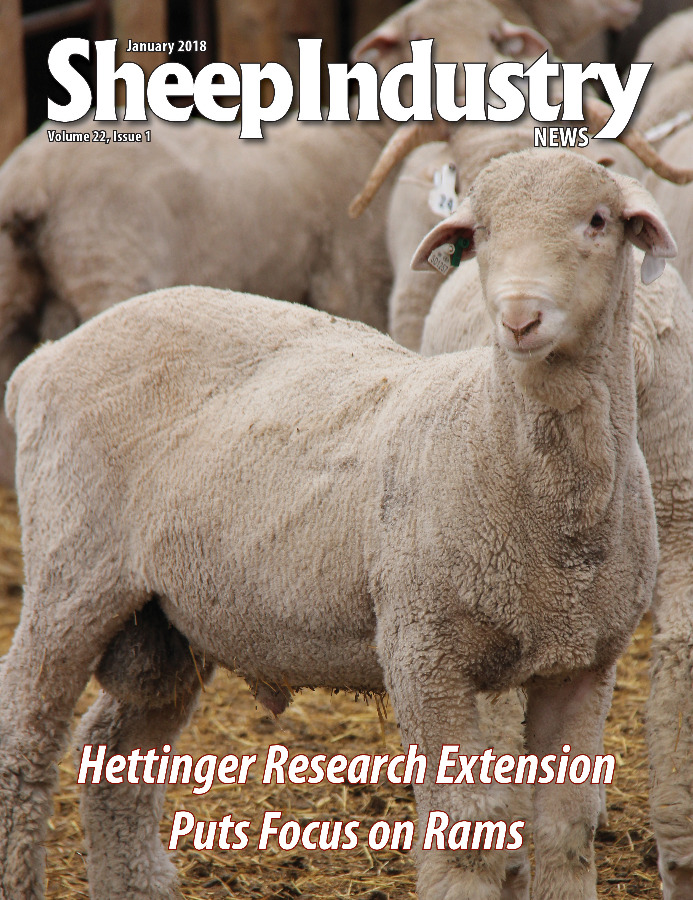
- January 2018
- President’s Notes
- Jerry King Cartoon
- Defining Lamb
- Ram Focused Research Keeps Hettinger Busy
- Menzies, Kent Selected for Wool Excellence Awards
- Let’s Grow Update: California Range Ram Index
- American Wool Exports Increase
- Data Drives Meinders Farm
- The Minnesota Project
- Obituary: Samuel Chournos
- Market Report
- The Last Word
Let’s Grow Update
Development of a Range Ram Index Utilizing Ultrasound Genetic Measures
OBJECTIVE: Develop a Range Ram Index utilizing ultrasound carcass measurements collected at the 2016 California Ram Sale to measure the expected value return of the heritability of carcass characteristics of a range ram through its progeny. The Range Ram Index was calculated using the following carcass characteristics: loin eye area, loin depth, fat thickness and ram weight. An interactive consignor educational program provided an overview of the development of ultrasound in the livestock industry, the practical application of ultrasound techniques in a range/commercial setting for carcass evaluation, benefits of the quantitative data of ultrasounding in a value-based pricing system, and how the data can be utilized in the producers’ breeding program.
Change comes slowly in the sheep industry at times, but as the old saying goes, “A journey of a thousand miles begins with one step.” Creating a valuable Range Ram Index for buyers at the California Ram Sale is a process that began with a Round 2 Let’s Grow grant in 2016, but continues to this day. As mentioned above, the index was calculated using loin eye area, loin depth, fat thickness and ram weight.
“In the past at this sale, there was virtually no information other than the name of the consignor, so I think buyers found the information interesting in 2016, but I’m not sure how much attention they really paid to it when purchasing rams,” said Let’s Grow Program Coordinator Alan Culham, who has attended the sale each of the past two years.
A survey following the 2016 sale confirmed Culham’s take. “Consignors believed that the buyers did not understand the concept of the Ram Index, nor had any interest in applying it in their purchasing decisions,” read a report to the Let’s Grow Committee.
Even as indexes from the National Sheep Improvement Program become common in the industry, there’s still work to do in showing sheep producers how to apply such information to decisions such as buying sheep, breeding, culling, etc.
“What I noticed in the second year (in 2017) was that index on nearly every pen of rams was 100, which is average for the index,” Culham said. “Most of the pens seemed to have a ram or two that was above average and a ram or two that was below average, and they averaged out to average.
“The consignors at the top end of the sale seemed to be the ones who used the index to put their top rams together in one pen,” Culham continued. “It’s a learning process when you start something like this, and I think in the second year, the buyers seemed to be a little ahead of the consignors on figuring out the system. Overall, the most valuable aspect of the program was that it gave buyers something to think about – other than what the ram looks like – before they bought rams.”
According to the final report from the California Wool Growers Association, “The Ram Index is designed as an alternative for producers to use when evaluating range rams that do not have established EBVs. Regardless of the buyers’ or consignors’ use of genetic selection tools such as the Ram Index, it was apparent during the sale that consignors and buyers were actively engaged and interested in the carcass performance provided on the rams sold. In reviewing the sale data, survey responses and conversations with stakeholders there was a positive correlation between the value paid for rams and the Ram Index, suggesting that some buyers may have been willing to pay more for rams with more desirable carcass traits.”
More importantly than higher prices at one sale is the education process that was begun in 2016 and continues to this day.
“It can also be concluded that as a result of this project, all parties became aware of the industry’s efforts in utilizing genetic improvement tools to produce a more consistent and desirable product and improve producer profitability to ensure the economic viability of the sheep industry,” the report stated.
CWGA Executive Director Erica Sanko said, “Our Ram Sale Committee is committed to continuing the efforts to enhance the educational aspects of genetic improvement at the California Ram Sale, and continued to use the Ram Sale Index in 2017 and will continue in 2018 and future years. CWGA also has policy regarding such educational efforts regarding using the ultrasound technique to improve production practices and lamb quality.
“The Ram Sale Committee is considering adding scrotal circumference as a variable to the index. The committee is still finalizing the best way to collect the data given our sifting process and ensuring the data collected is consistent. It has not been decided whether to include this variable into the index for 2018 or not.”

